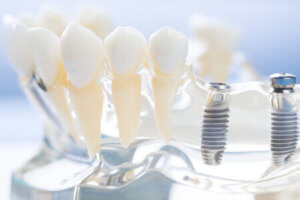What are dental implants? Check out our guide about dental implants where we discuss the procedure, the different types, and who should get dental implants.

If you are missing teeth, it may be affecting your bite alignment, your facial shape, and the aesthetics of your smile. Tooth loss may result from gum disease, physical trauma, cavities, or other factors. When you are looking to replace missing teeth, dental implants are an excellent option.
What are dental implants? Well, in this blog post, we are going to answer that question. We are also going to look at the different types of implants that are available, the surgery timeline, recovery, and advantages.
According to statistics, 120 million people in the United States are missing at least 1 tooth. More than 36 million do not have any teeth. It is expected that these numbers will rise over the coming years, meaning that more and more people will opt for dental implants.
What Are Dental Implants?
Dental implants are artificial tooth roots used to support false teeth in the mouth. It is possible to have a single tooth replaced with an implant or a complete set. They are generally manufactured from titanium, a metal that is compatible with body tissues.
They are a well-established and safe type of dental treatment. They are surgically placed into the jawbone and there are two types of dental implants: endosteal and subperiosteal. Let’s take a closer look at each of these in turn.
Endosteal
This is the most common type of dental implant and is surgically inserted deep into the jawbone. Here, they take the place of tooth roots and support one or several teeth. In appearance, they resemble small screws.
Subperiosteal
If your jawbone is not sufficiently healthy to support an endosteal dental implant, another option is subperiosteal. Rather than drilling into the jawbone itself, the surgeon inserts them under the gum and placed on or above the bone (rather than in it).
What Is the Surgery Timeline for Dental Implants?
A dental implant requires a number of steps over a period of between 3 to 9 months depending on the specific case. In this section, we will look at each of the different steps involved in getting dental implants.
Initial Evaluation
This initial evaluation will look at your teeth, gums, and jawbone. This evaluation will determine whether or not your jawbone is healthy enough to maintain a dental implant.
In some cases, for example, if the jawbone is too soft or thin, another procedure such as a bone graft may be required during commencing with the dental implant process. You may also require treatment for periodontal disease.
This evaluation will also determine how many teeth the dental implants will replace. This will affect the scope of the overall dental implants procedure going forward.
Placing the Implant
During an endosteal implant, the surgeon will expose the jawbone by cutting the gum and drilling holes into the bone to insert the implant post. Until the permanent tooth is attached to the implant, you may choose to have a removable denture placed over the hole.
In the case of a subperiosteal implant, the dental implant goes above or on the bone.
Some swelling and discomfort is normal in the days following the surgery, though regular daily activities can resume the following day. Contact your surgeon if you experience any pain, swelling, or bleeding that persists for more than several days following the procedure
Osseointegration Stage
It will take approximately 2 to 6 months before sufficient new bone growth around the dental screw has occurred. This stage is known as osseointegration. The natural jaw bone grows around the dental implant and strengthens, which helps to keep it in place and function as an artificial tooth root.
Placing the Abutments
An abutment is a metal extender added to the dental implant. It is either placed during the initial procedure or separately later. They help to connect the replacement tooth or teeth to the dental implant.
If the abutment is added separately following the initial procedure, the gums will be given several weeks in order to heal after the placement.
Placing the Tooth or Teeth
Your dentist will take an impression of your teeth once healing is complete and a permanent replacement tooth will be created.
There is the option to opt for a removable or fixed tooth. A removable tooth can be removed for regular cleaning, while the fixed tooth will be permanently screwed or cemented onto the aforementioned abutment.
Just like your regular teeth, your new implant must be cared for with brushing and flossing. Regular dental checkups are advised.
What Are the Advantages of Dental Implants?
Some of the primary advantages to dental implants include:
- Improved speech
- Improved appearance
- Easier eating
- Improved comfort
- Improved oral health
- Improved self-esteem
- Highly durable
On that last point, dental implants will last for many years. With proper care, they may even last a lifetime.
Everything You Need to Know About Dental Implants
So, what are dental implants? They are a long-term, cost-effective, and healthy solution to missing teeth. The above guide to dental implants highlights the benefits of dental implants and how they can be a permanent solution to missing teeth.
Here at Boise Oral Surgery & Dental Implant Center, Dr. Bobst and his expert team are your No. 1 option for dental implants. We are extensively trained to provide the highest quality dental implants and oral surgery.
Contact our friendly and professional team today and schedule a consultation about dental implants. We look forward to speaking with you and helping to improve your oral health.
